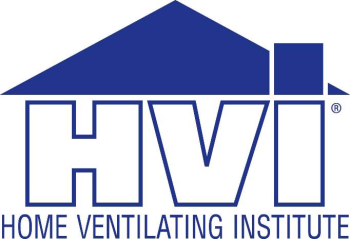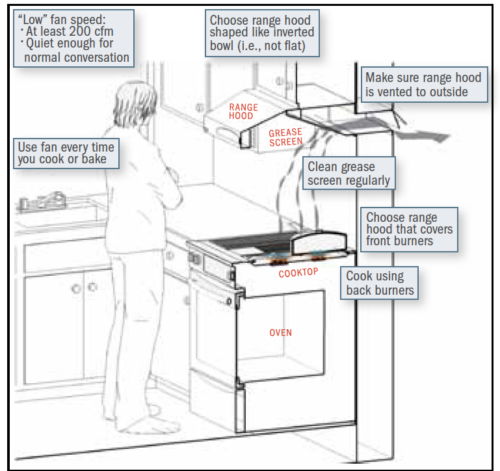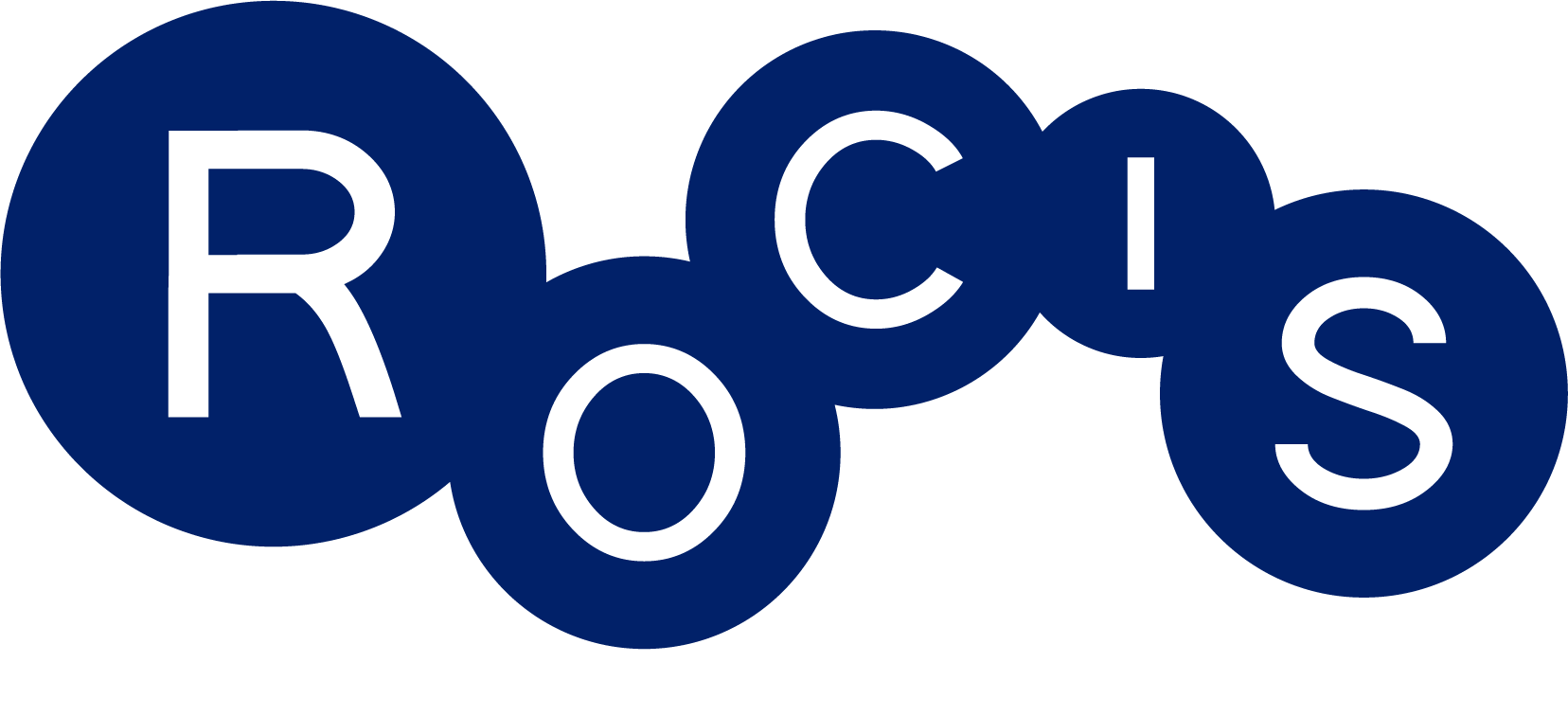ROCIS Kitchen Range Hood Issue Brief
This brief was created by Tom Phillips to help homeowners and building professionals understand the ins and outs of kitchen range hoods. The resources below are supplements to this brief.
Ducted Range Hoods: Recommendations for New and Existing Homes
Thomas J. Phillips | ROCIS Principal Investigator | December 2019
WHAT IS A DUCTED RANGE HOOD?
Ducted range hoods are metal or glass devices installed above cook stoves and ovens. Usually shaped like an inverted funnel or bowl to capture the cooking emissions, they employ a fan and ductwork to remove pollutants directly to the outdoors. Range hoods are also known as kitchen hoods, exhaust hoods, fan hoods, and extractor hoods. Some microwave ovens mounted above stovetops also have an exhaust fan and ducting to move cooking emissions outdoors. However, ductless (or recirculating) range hoods lack a vent to the outside and do not effectively remove cooking emissions, even if the hood has grease, particle, or charcoal filters.
Note: unless specified otherwise, the following recommendations will only be referring to ducted (vented) range hoods that exhaust to the outside of homes.
WHY DO HOMES NEED A DUCTED RANGE HOOD?
Cooking produces odor, moisture, and air pollutant emissions in homes, whether done with a gas or an electric appliance.(1) Indoor pollutant levels from cooking can exceed health guidelines for particulate matter, nitrogen dioxide, carbon monoxide, and aldehydes, especially for gas stoves.(2) These pollutants can increase the risk of both short-term and long-term health effects.(3) Residential cooking or space heating with a gas stove has been associated with respiratory problems in children, especially in unventilated kitchens.(4) Cooking can also emit potent mutagens and carcinogens into the air,(5) and the large amounts of moisture emitted by cooking can increase the risk of bio-allergens such as mold, bacteria, and dust mites multiplying in a home.(6)
Using a range hood can help reduce pollutant exposures and health impacts from cooking, by keeping emissions from spreading into and lingering in a home.(7) Opening windows alone is not nearly as effective as a good range hood, especially when wind speeds are low or outdoor pollutant levels are high. Range hoods also help cool a house by removing excess heat and moisture from cooking. They are required for new home construction, major remodels, and additions, and recommended by green and healthy building programs,(8) ventilation industry standards,(9) and state and local building codes.(10)
WHO NEEDS A DUCTED RANGE HOOD?
Everybody who cooks with a stove or oven needs to use a range hood—especially if your household includes children, persons with asthma or other respiratory diseases, the elderly, or persons sensitive to odors. The more burners you use, the longer you cook, and the more the cooking produces odors, smoke, or moisture, the more you need to use effective kitchen exhaust ventilation. Range hoods are also essential for smaller homes with less volume to dilute the cooking emissions. Anybody planning a new home, remodel, or replacement of any range hood should take advantage of the opportunity to install a better range hood system.
WHEN AND HOW DO I NEED TO OPERATE A DUCTED RANGE HOOD?
Use the hood whenever you use the stove or oven and especially when cooking at high temperatures or producing large quantities of steam, smoke, or odors. Examples of “high emitting” cooking activities include grilling, frying, stir-frying, broiling, and roasting. Operate the hood fan at the speed that seems to best remove smoke, odors, and steam at the highest noise level your household can tolerate.
Use a back burner whenever possible. Also, use lower cooking temperatures, and cover pots and pans as much as possible.
Leave the fan on for at least 10–20 minutes after the cooking ends or until the cooking surfaces have cooled, whichever comes first.(11) Continue using the fan if odors or smoke are noticeable when you enter from outdoors or a distant part of the house. (For airtight homes, see Supplement 3: Caveats and Cautions.)
Minimize movements of the cook and cross drafts near the stove, in order to maximize cooking fume capture and removal.
When using the oven cleaning cycle, evacuate the house and operate the range hood at maximum speed. Also, clean the hood’s grease filters afterward.
HOW DO I SELECT A "GOOD" DUCTED RANGE HOOD?
The best range hood to meet your needs depends on your building and appliance characteristics, your type of cooking, your household’s sensitivity to odor, pollutants, and noise, and your budget. (See Supplement 2: Criteria for Selecting an Effective Ducted Range Hood.)
Determine the airflow rate you need for your hood type, stove size, building airtightness, and type of cooking. Airflow rates for typical homes should be 200–350 cubic feet per minute (cfm). Island installations will require higher flows than wall installations.
Select a hood with a Capture Efficiency (CE) of 80% or more based on ratings from Home Ventilating Institute (HVI) or the manufacturer if necessary. HVI’s third-party certification program for CE is expected by 2019.(12) If CE ratings are not available yet, pick a deep, wide hood that has an open bottom and that covers all the burners.(13)

Certified Home Ventilating Products Directory
HVI provides third-party, certified test results for airflow (cfm) and noise (sone) for range hoods. Capture Efficiency ratings are being developed. Note: Some manufacturers may report their own test results, often for multiple fan speeds, but the results may not be accurate.
Select a range hood that is quiet. Look for a hood with an HVI noise rating of less than 3 sones at an airflow rate of 200 cfm or more. If you need a larger capacity range hood that does not have a sone rating at 200 cfm, choose one that has a lower sone rating than others at equivalent speeds.
Select a multispeed fan that can be used at lower flow rates and sound levels when cooking with low emissions or on small burners.
Make sure the hood and ducting will fit. Ensure that the hood dimensions from the manufacturer and the duct layout can be accommodated in the available space. Double-check that the hood and ductwork are installed properly.
Measure the flow rates of the installed hood. (See Supplement 4: How to Install Ducted Range Hood Systems.)
Some cautions:
High airflow rates (and even low rates in airtight homes) can depressurize a home, potentially pulling in unwanted pollutants from combustion appliances, outdoor air, soil, or attached garages, basements, or apartments. This may create a need for make-up air. (See Supplement 3: Caveats and Cautions.)
Conventional flat “designer” style hoods are not very effective, based on available data. Also, many existing range hoods with propeller-type fans and small-diameter ducts are not very effective and are too noisy.
Some over-the-range microwaves can effectively remove indoor pollutants, but only at very high (and noisy) fan speeds and flow rates.
Large “power” burners produce much more heat and pollutant emissions than typical gas burners and may need a wider range hood and higher airflow rates.
WHAT ELSE CAN I DO?
Regardless of whether you have an effective ducted range hood, there are some easy ways to further reduce indoor pollution exposures from cooking and to improve pollutant removal by the hood, such as reducing cooking emissions and funneling the plume into the hood. (See Supplement 1: Easy Ways to Reduce Exposures to Cooking Pollutants.)
Tips for Effective Range Hoods
- A quiet, ducted (vented) range hood should be installed in new and existing homes and used whenever you cook.
- Low-emission cooking practices and hood side extensions can also help reduce exposure to cooking pollution, odors, and moisture.
Image: Stratton, 2015.

1 Fortmann et al., 2001; Fluckiger et al., 2000; Dennekamp et al., 2001; Parrott et al., 2003; Svedahl et al., 2009; Arbex et al., 2007; Zhang et al., 2010; Jørgensen et al., 2013
2 Fortmann et al., 2001; Logue et al., 2011; Singer et al., 2017; Borsboom et al., 2018; O’Leary et al., 2018
3 Coker et al., 2015; Belanger et al., 2006
4 Dekker et al., 2001; Coker et al., 2015; Kile et al., 2014
5 Felton, 1995; Knize, 2006; Sjaastad et al., 2010; NCI, 2017; Poudel et al., 2017; Sohn, 2017
6 US EPA, 2015
7 Fluckiger et al., 2000; Fortmann et al., 2001; Kile et al., 2014; Jacobs et al., 2016; Jacobs & Borsboom, 2017; Singer et al., 2017; Pacitto et al., 2018
8 US EPA, 2015; Build It Green, 2017; USGBC, 2017
9 ASHRAE, 2016
10 Stratton & Singer, 2014
11 Sjaastad & Svendsen, 2010; AIVC, 2019
12 Windmeyer, 2019
13 Singer et al., 2012; Borsboom et al., 2016
Additional Information about Kitchen Hoods
About the Author
Tom Phillips, ROCIS Principal Investigator
Thomas J. Phillips (Tom) spent over 30 years working at the intersection of research and policy addressing public health, pollution, and buildings. While at the Research Division of the California Air Resources Board (CARB) from 1985 to 2009, he designed and managed research contracts on human activity patterns, indoor and personal air exposure monitoring, air cleaning, emissions testing, and building ventilation. He produced guidelines on indoor combustion pollutants and air cleaning devices and helped update California’s air quality and building ventilation standards.
Tom also served as a technical advisor to national, state, and local agencies and NGOs on various IAQ issues and green building programs for homes, schools, and offices. Since 2010, Tom has served as the principal scientist at Healthy Building Research, where he co-authored a research roadmap for indoor environmental quality in net zero energy buildings and retrofits for California’s energy program through 2030. The scope of his consulting work also includes climate change adaptation to extreme heat, resilient buildings and communities, training and communication, and policy and regulation.
Acknowledgments
Fellow ROCIS team members Linda Wigington, Don Fugler, and Rob Busher provided the encouragement and assistance that made this project happen. Numerous technical experts provided invaluable input on draft versions of this document, helping to greatly improve this version.
The creativity and generosity of the numerous researchers who provided the evidence supporting this document was amazing. Valerie Urso provided excellent production assistance. We are especially thankful to The Heinz Endowments for partial support for this project.
ROCIS would also like to acknowledge the valuable input provided for the Range Hood Guidance Document from the industry professionals listed below. The following people helped to shape the accuracy and presentation of the document:
Anthony Cox – Community Housing Partners
Paul Eldrenkamp – Byggmeister Design Build
Patrick Huelman – University of Minnesota
Graham Irwin – Essential Habitat Architecture
Dave Jacobs – National Center for Healthy Housing
Kurt Johnson – Fresh Air Ventilation Systems
Michael Lubliner – Washington State University
Rhett Major – The Energy Doctor
Bert Phillips – UNIES Ltd.
Srikanth Puttagunta – Steven Winter Associates, Inc.
Harold Rickenbacker – University of Pittsburgh
Brett Singer – Lawrence Berkley National Laboratory
Chris Stratton – JCS Design Build
Peter Troast – Energy Circle
Bill Turner – Turner Building Science & Design LLC
Iain Walker – Lawrence Berkley National Laboratory
Lance Wallace – U.S. EPA (retired)
Jonathan Wilson – National Center for Healthy Housing
Charles Withers, Jr. – University of Central Florida
Greg Wozniak – G.A. Wozniak & Associates
